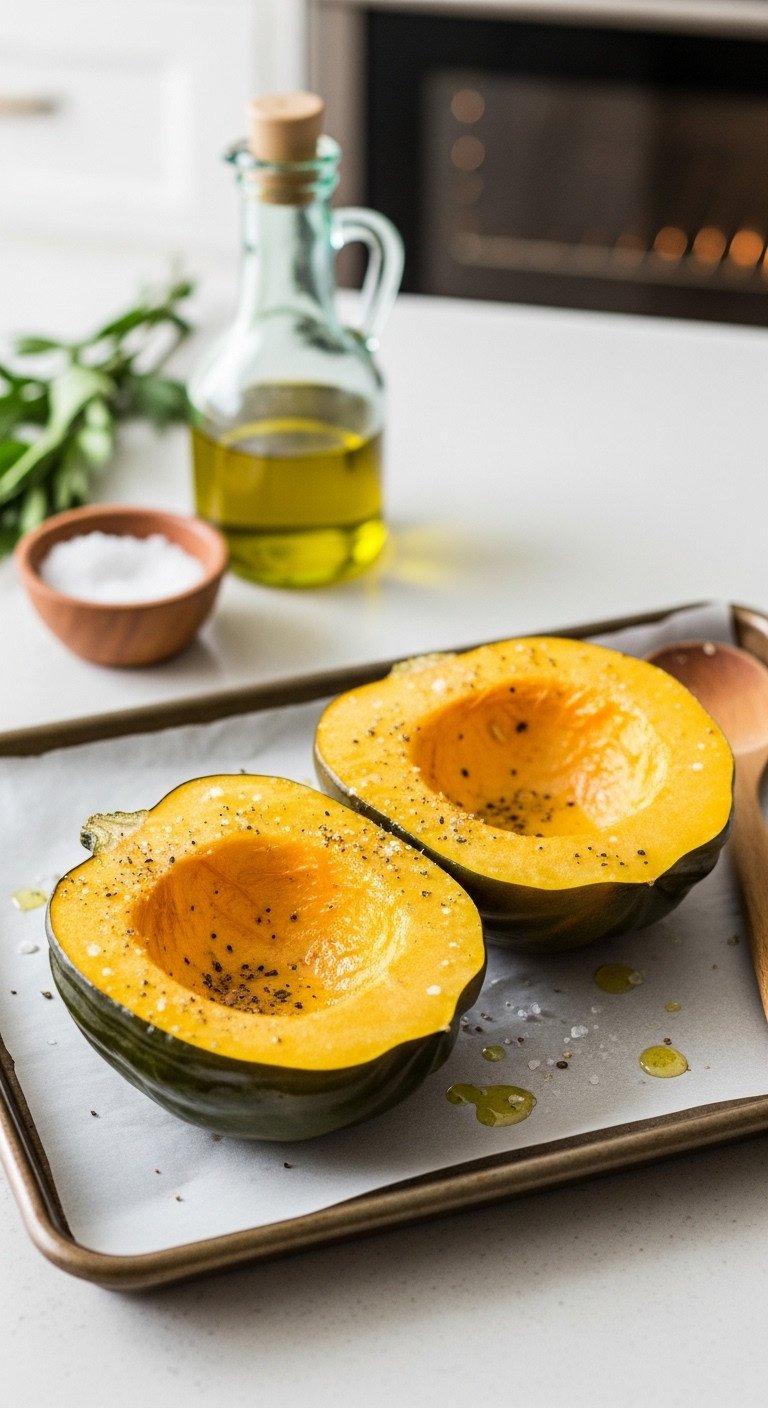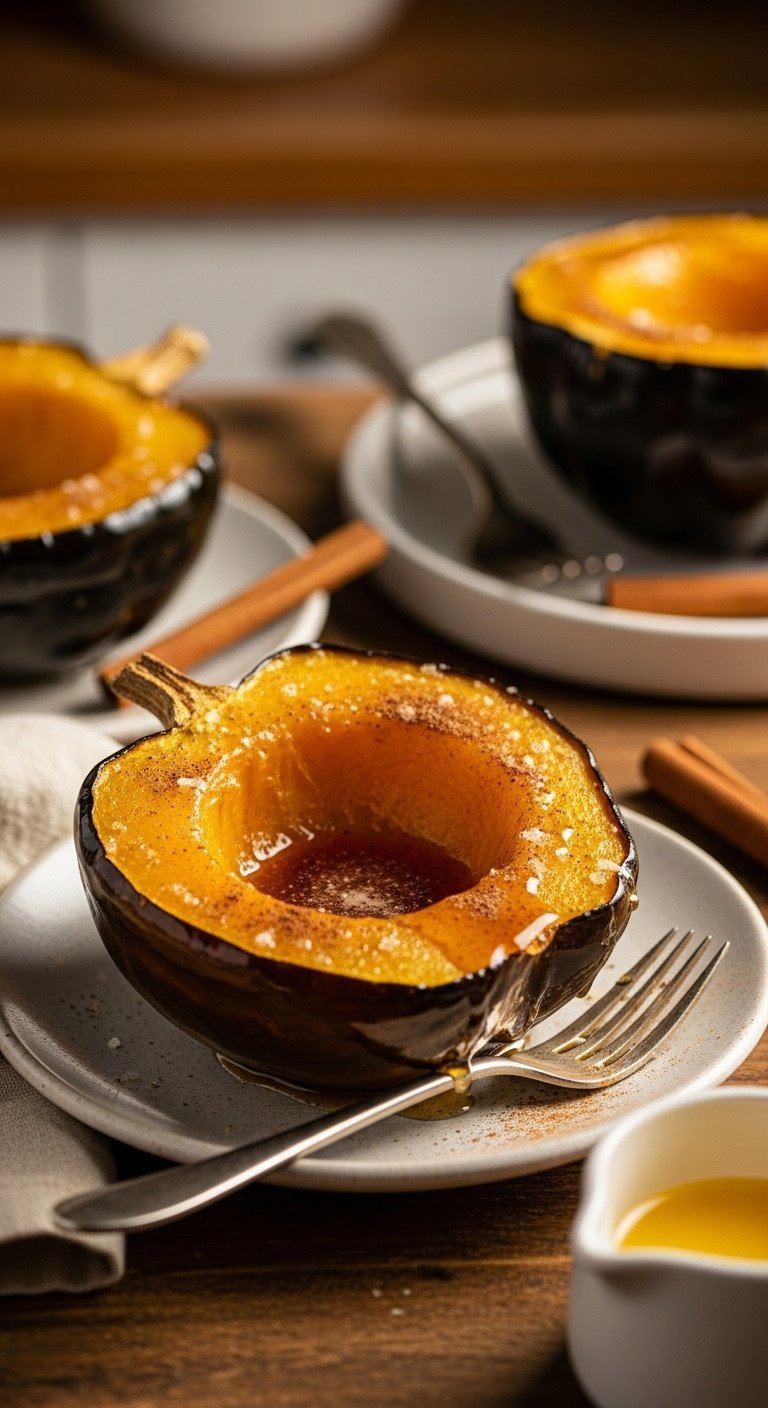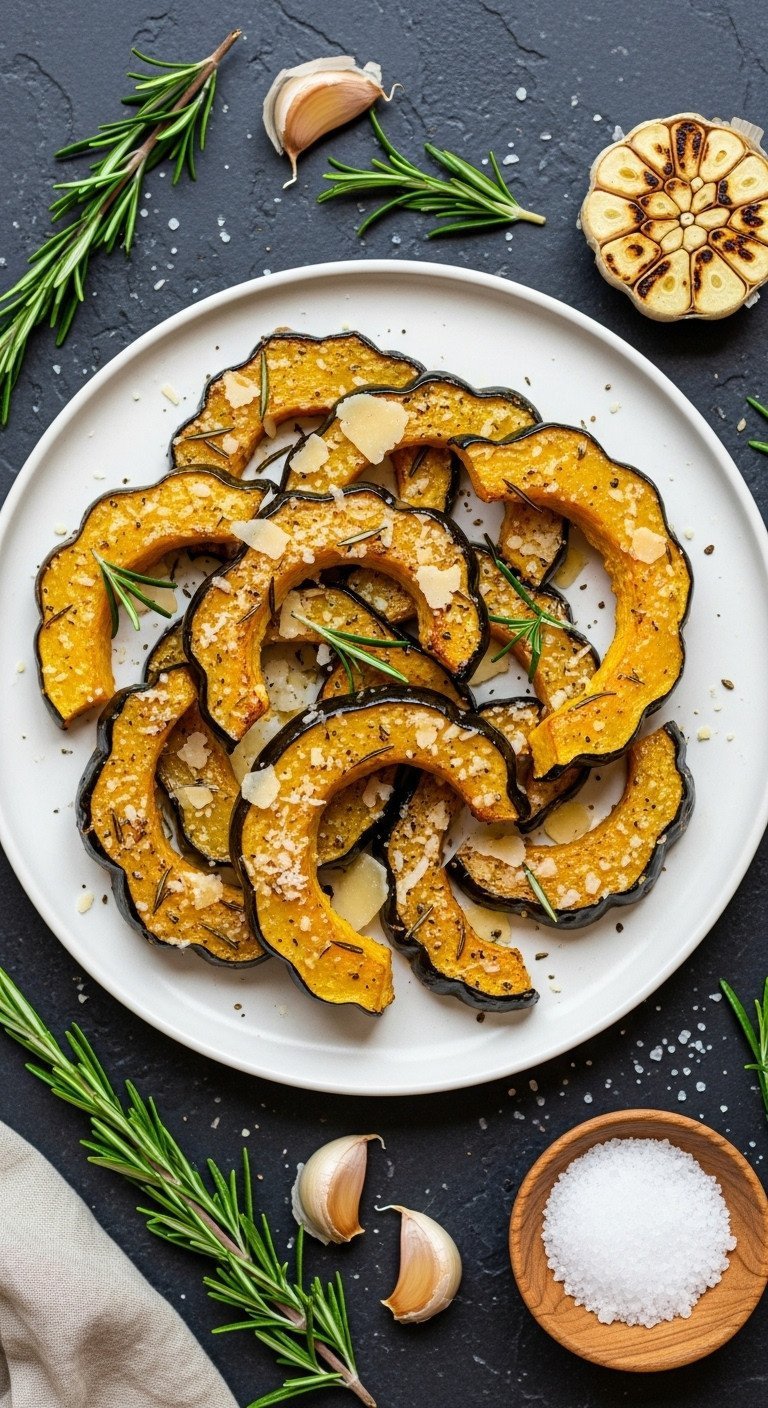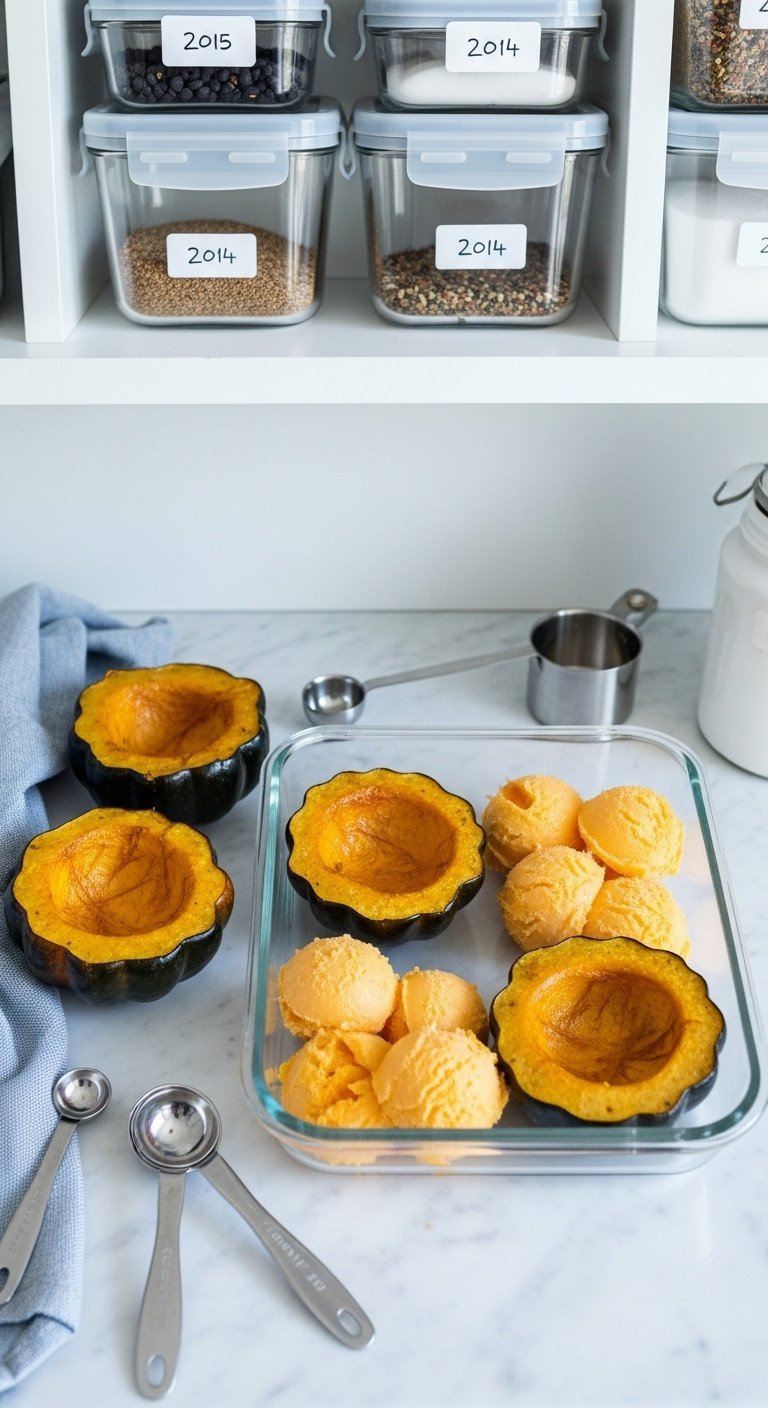As an Amazon Associate KitchenwareSets.com earns from qualifying purchases.
Ultimate Acorn Squash Recipe Sweet And Savory Guide
Tired of wrestling with a rock-hard squash only to get tough, stringy results? You’re not alone. The frustration of trying to safely cut and perfectly cook this fall favorite is a common kitchen struggle.
An acorn squash recipe is a culinary procedure for preparing this versatile winter squash, known for its hard rind and sweet, nutty flesh. The biggest challenge is transforming that tough exterior into a fork-tender, flavorful dish without it becoming dry or mushy.
Perfectly cooked acorn squash is fork-tender, meaning the flesh offers little resistance when pierced, with visibly caramelized, golden-brown edges. This guide delivers tested, reliable methods based on culinary science to guarantee a safe prep and a delicious outcome every single time.
Frustrated by Hard Squash? Why This Ultimate Guide Delivers Perfect Tender Flesh
Many home cooks feel the frustration of a beautiful acorn squash turning out dry, tough, or undercooked. The problem often lies in two areas: the initial, often hazardous, preparation of cutting the hard rind, and the mystery of finding the perfect time and temperature to achieve tender flesh. This isn’t just a simple recipe; it’s a guide built on tested culinary science principles.
We’ll move beyond guesswork. By understanding how high heat triggers the Maillard reaction to create deep, caramelized flavor and how proper technique converts starches into sugars, you can achieve consistently perfect results. This ultimate acorn squash guide focuses on safe, efficient preparation and reliable cooking methods, turning a challenging vegetable into a simple, delicious fall side dish.
7 Tested Methods to Achieve Ultimate Acorn Squash Sweet and Savory Perfection
From a classic sweet side dish to a robust savory main, acorn squash is incredibly versatile. All of the following methods have been tested in a home kitchen environment to confirm reliable cooking times and ingredient ratios, ensuring your final dish is a success. We’ll start with the most critical step—safety—and build from a foundational recipe to more complex and delicious variations.
1. Safety First: The Microwaving Trick for Safer Cutting

Pin this genius hack to your ‘Kitchen Safety’ board!
The hard, thick rind of an acorn squash is the biggest barrier for many cooks. Applying brute force with a knife is not only difficult but also dangerous. The secret to easy, safe cutting is to slightly soften the exterior first.
Tools Needed:
- Sturdy Chef’s Knife (with 8-inch blade, full tang)
- Large, Non-Slip Cutting Board (ensure stability with rubber feet)
- Heavy Dish Towel or Damp Cloth
- Small Paring Knife or Vegetable Peeler (optional, for scoring)
Step-by-Step Directions:
- Stabilize: Trim a tiny, thin slice off the bottom of the squash so it sits perfectly flat and won’t roll. This is the most crucial safety step.
- Score (Optional but Recommended): Use the tip of a paring knife to score a line around the center circumference of the squash. This gives your main knife a path to follow.
- Soften (The Trick): Place the whole, uncut acorn squash in the microwave on high heat for 3 to 5 minutes. This softens the exterior rind just enough for safe cutting without cooking the inside.
- Cut Safely: Place the flat, trimmed side down on the cutting board (with a damp towel underneath for extra stability). Slowly and firmly press your sharp chef’s knife along the scored line, working downward toward the board.
- Remove Seeds: Use an ice cream scoop or a sturdy spoon to efficiently scrape out the seeds and fibrous strings from the cavity. An ice cream scoop has a sharper edge that cleans the cavity perfectly.
A great pro-tip if you lack a microwave is to carefully puncture the skin in several places with a fork. Then, pierce through the squash horizontally into a large, sturdy glass bowl and use that as leverage to split the squash cleanly.
2. Foundational Recipe: Perfectly Baked Acorn Squash Halves

Save this core roasting method for perfect squash texture!
Before adding glazes or stuffings, mastering the basic roast is key. This method focuses on achieving that perfectly soft and tender flesh that serves as a canvas for any flavor profile.
Ingredients Needed:
- 2 Medium Acorn Squash (about 1.5 lbs each, with a dull exterior)
- 2 Tbsp Olive Oil (or melted coconut oil for high heat)
- 1 tsp Coarse Sea Salt
- 1/2 tsp Freshly Ground Black Pepper
- (Optional) Water or Broth (1/4 cup for pan to prevent dryness)
Step-by-Step Directions:
- Preheat: Preheat your oven to 400°F (200°C). Line a large metal baking sheet with parchment paper for easy cleanup.
- Prep: Ensure squash halves are cleanly seeded as per the safety method above. Pat the cut flesh dry with a paper towel to help the oil adhere.
- Season: Place the halves cut-side-up on the prepared baking sheet. Drizzle or brush the flesh and edges evenly with olive oil. Sprinkle generously with coarse sea salt and black pepper.
- Initial Roast: Bake for 30 minutes. If your oven runs hot or your squash tends to dry out, you can loosely cover the baking sheet with foil for this initial phase to trap steam.
- Test for Doneness: After 30 minutes, remove the foil (if used). Continue roasting uncovered for another 15–30 minutes. The squash is perfectly cooked when a fork easily pierces the thickest part with no resistance.
- Serve: Remove from the oven and allow to rest for 5 minutes before serving. This allows the flesh to set slightly.
For more browning, check the squash at the 45-minute mark. If it’s tender but not caramelized, raise the oven temperature to 425°F for the final 10 minutes.
3. Classic Sweet Side Dish: Brown Sugar and Butter Glaze

Save this classic Thanksgiving side dish!
This is the quintessential sweet acorn squash recipe, a holiday favorite for a reason. The combination of butter and brown sugar creates a self-basting glaze that caramelizes beautifully in the oven’s high heat.
Ingredients Needed:
- 2 Acorn Squash Halves (pre-roasted for 30 minutes, or raw)
- 4 Tbsp Unsalted Butter (cut into 4 pieces)
- 4 Tbsp Packed Light Brown Sugar (ensure it’s moist for best results)
- 1/2 tsp Ground Cinnamon (or a pumpkin pie spice blend)
- Pinch of Salt (to balance the sweetness)
Step-by-Step Directions:
- Prep Squash (If Raw): Prepare and season the squash halves as detailed in the Foundational Recipe (Method 2, Steps 1-3).
- Basting Fill: Place one tablespoon of butter and one tablespoon of packed brown sugar into the cavity of each squash half. Sprinkle with cinnamon and a tiny pinch of salt to enhance the flavors.
- Bake: Return the squash to the oven, cut-side up. Roast for 35–45 minutes. For maximum flavor, baste the flesh and cavity with the melted glaze every 15 minutes to encourage an even coating and deep caramelization.
- Glaze Check: The dish is ready when the flesh is completely fork-tender and the sugar glaze is thick, bubbly, and has caramelized around the edges of the squash.
- Rest: Let the squash rest for 5 minutes before serving, which allows the glaze to thicken slightly. Spoon any excess glaze from the cavity over the flesh.
To prevent the sugar from burning before the squash softens, consider adding the butter and brown sugar filling about 15 minutes into the roasting time if you are starting with raw squash.
4. Robust Savory Side: Parmesan, Garlic, and Rosemary Roast

Pin this savory herb roast recipe for weeknight dinners!
For those who prefer a less sweet side, this savory version transforms acorn squash with robust herbs and the salty, crisp texture of baked Parmesan cheese. It pairs perfectly with roast chicken or turkey.
Ingredients Needed:
- 2 Acorn Squash (cut into 1-inch thick wedges or 1/2-inch thick rings)
- 4 Tbsp Quality Olive Oil (extra virgin)
- 1 tsp Garlic Powder (or 2 crushed cloves fresh garlic)
- 1 Tbsp Fresh Rosemary (finely chopped)
- 1/2 Tbsp Fresh Thyme Leaves
- 1/2 cup Grated Parmesan Cheese (freshly grated provides the best texture)
- Coarse Salt and Black Pepper to taste
Step-by-Step Directions:
- Prep & Toss: Preheat your oven to 400°F (200°C). In a large bowl, toss the squash wedges or rings with 3 Tbsp of the olive oil, garlic powder, fresh rosemary, thyme, salt, and pepper until every piece is fully coated.
- Initial Roast: Spread the seasoned squash in a single layer on a parchment-lined baking sheet. Roast for 20 minutes for slices or 30 minutes for thicker wedges.
- Parmesan Layer: Remove the squash from the oven. Drizzle with the remaining 1 Tbsp of olive oil and toss generously with the grated Parmesan cheese.
- Finish Roast: Return the baking sheet to the oven and roast for another 10–15 minutes. The squash is ready when it’s very tender and the Parmesan has melted into a golden, crispy crust.
- Serve: Garnish with a sprinkle of extra fresh rosemary before serving to add a fresh, aromatic finish.
For the most robust savory flavor, fresh herbs are essential. If you must use dried herbs, reduce the quantity by two-thirds and toss them with the warm olive oil first to “bloom” their flavor before adding to the squash.
5. Maximizing Flavor: The Maple-Pecan Crunch Topping

Save this elevated holiday recipe for your next gathering!
This method elevates the classic sweet squash by introducing a delightful textural contrast. The creamy, tender flesh is topped with a crunchy, nutty crumble, creating a more complex and satisfying side dish.
Ingredients Needed:
- 2 Pre-Roasted Acorn Squash Halves (from Method 2)
- 4 Tbsp Maple Syrup (Grade A, dark or amber for richer flavor)
- 1/2 cup Pecans (roughly chopped)
- 2 Tbsp Melted Butter (or coconut oil)
- 2 Tbsp Flour or Almond Meal (to create the crumb)
- 1 Tbsp Granulated Maple Sugar (optional, for extra crunch)
Step-by-Step Directions:
- Roast Squash: Prepare the squash halves as described in the Foundational Recipe (Method 2), but only season with salt initially. Roast until the squash is about 10 minutes shy of being fully fork-tender.
- Make Topping: While the squash is roasting, combine the chopped pecans, flour or almond meal, melted butter, and optional maple sugar in a small bowl until a crumbly texture forms.
- Glaze and Top: Remove the partially cooked squash from the oven. Drizzle 1 Tbsp of maple syrup into each cavity and brush it lightly over the flesh. Sprinkle the pecan topping evenly over the entire surface of the squash.
- Finish Baking: Return the squash to the oven for the final 10 minutes, or until the topping is golden brown and fragrant, and the squash flesh is fully tender.
- Final Glaze: For an extra glossy finish, drizzle a final teaspoon of maple syrup over the toasted topping just before serving.
A lesson learned from testing: pecans can burn very quickly under direct heat. Ensure you only add the topping during the final 10–15 minutes of roasting to prevent it from scorching.
6. Main Dish Solution: Hearty Italian Sausage and Farro Stuffing

Save this clever organization idea!
This recipe transforms acorn squash from a simple side into a complete, balanced main dish. The combination of savory Italian sausage, nutty farro, and nutrient-dense kale creates a satisfying meal perfect for a cozy weeknight dinner.
Ingredients Needed:
- 2 Acorn Squash Halves (pre-roasted for 45 minutes, very tender)
- 1 cup Cooked Farro (or quinoa, prepared al dente)
- 1/2 lb Mild Italian Sausage (casing removed)
- 1 cup Chopped Kale or Spinach
- 1/2 cup Finely Chopped Onion
- 1/4 cup Grated Parmesan or Feta Cheese
- 2 Tbsp Olive Oil (for sautéing)
Step-by-Step Directions:
- Prep Squash: Roast the acorn squash halves (seasoned with salt and oil) at 400°F for 45 minutes until tender, but not mushy. The squash should be cooked through before stuffing.
- Cook Stuffing Base: While the squash roasts, heat olive oil in a skillet over medium heat. Sauté the onion until soft. Add the Italian sausage and cook, breaking it up with a spoon, until it is fully browned. Drain any excess fat.
- Combine Filling: Stir in the pre-cooked farro, chopped kale, and Parmesan or Feta cheese. Cook until the kale wilts slightly and the mixture is well combined. Season generously with salt and pepper.
- Stuff and Heat: Carefully spoon the filling mixture into the cavities of the roasted squash halves, piling it high.
- Final Bake (Food Safety Check): Return the stuffed squash to the oven for 10-15 minutes. This final bake is to heat the filling through and meld the flavors. The dish is ready when a digital instant-read thermometer registers 165°F (74°C) in the center of the sausage stuffing.
A critical food safety pro-tip: because the filling contains meat, always use a digital instant-read thermometer to confirm the center of the stuffing reaches a safe internal temperature of 165°F (74°C) before serving.
7. Post-Cook Prep: The Smart Guide to Storing and Reheating

Pin this easy meal prep guide!
Properly storing and reheating cooked squash is key to enjoying your leftovers without sacrificing texture. Following these simple steps ensures your squash tastes just as good the next day.
Supplies Needed:
- Airtight Glass Storage Containers (BPA-free, oven-safe)
- Aluminum Foil (for reheating)
- Large Spoon or Ice Cream Scoop
- Freezer Bags (heavy-duty, if freezing)
Preservation and Reheating Guide:
- Cool Completely: Before storing, allow all cooked squash (whether stuffed or unstuffed) to cool completely at room temperature for no more than two hours.
- Refrigerate Halves: For short-term storage of 3–4 days, place the cooked, cooled squash halves directly into an airtight container and refrigerate.
- Optimal Reheating (Halves): The oven is the best method. Preheat it to 350°F (175°C). Place the squash halves cut-side down in a baking dish, add a splash of water or broth to the dish, and cover tightly with foil. Reheat for 15–20 minutes until heated through. The steam created by the liquid prevents the squash from drying out.
- Freezing (Best Mashed): For long-term storage, the texture holds up best if mashed. Scoop the flesh out of the skin, mash it lightly, and portion it into freezer bags or airtight containers. Label with the date. Frozen mashed squash lasts up to 6 months and is perfect for adding to soups or quick breads.
- Microwave Warning: While fast, reheating in the microwave often results in tough, rubbery edges and uneven heating. Use the oven method whenever possible for superior texture retention.
When reheating stuffed squash, sprinkle a few drops of water over the stuffing before covering it with foil to prevent the grain or meat from drying out.
Mastering the Roast: Time, Temperature, and Culinary Science
Understanding the “why” behind the cooking process is what separates a good recipe from a great one. The right combination of time and temperature doesn’t just cook the squash; it transforms it by developing deep, complex flavors and a perfect, creamy texture.
The Acorn Squash Time and Temperature Comparison Chart
The ideal roasting temperature for acorn squash is between 400°F and 425°F. While a lower temperature like 375°F will cook the squash, higher heat is critical for accelerating the Maillard reaction. This chemical process is responsible for the deep, complex flavors and caramelized edges that maximize the natural sweetness of the squash.
| Temperature (F/C) | Preparation | Expected Time (Minutes) | Result/Texture Profile |
|---|---|---|---|
| 375°F (190°C) | Halves, covered | 60–75 min | Very moist, minimal caramelization, ideal for mashing. |
| 400°F (200°C) | Halves, uncovered | 45–60 min | Tender flesh, good browning, optimal balance of speed and texture. |
| 425°F (220°C) | Halves, uncovered | 35–45 min | Fastest cook time, superior caramelization and crispy edges, highest risk of drying out. |
| 425°F (220°C) | 1-inch Slices/Rings | 20–30 min | Very fast cooking, best for eating the skin, maximum crispness. |
Why High Heat is Essential for Flavor Depth
High heat is essential because it triggers the Maillard reaction, the chemical process that caramelizes the squash’s natural sugars and any added sweeteners (like brown sugar or maple syrup). This process is responsible for the rich, nutty, golden-brown edges and the intense flavor depth often missing in lower-temperature baked squash. Without it, the squash is simply steamed in its own moisture, resulting in a blander, sometimes watery flavor profile.
Avoiding the Dry Squash Dilemma
To prevent dry squash, ensure the flesh is generously coated in fat (butter or oil) and consider placing a small amount of liquid (1/4 cup of water or vegetable broth) in the bottom of the roasting pan. This simple trick creates steam within the oven, which keeps the immediate environment humid. This allows the squash’s interior to cook to a tender, creamy consistency before the exterior gets a chance to dry out, ensuring maximum moisture retention.
Key Takeaways: Your Quick Guide to Roasted Acorn Squash
Here is a scannable summary of the most important points to ensure your acorn squash is perfect every time.
* The Three Core Paths: Acorn squash is highly versatile, providing three distinct serving paths: 1) A quick, simple Savory Side Dish (rosemary, Parmesan); 2) A comforting Sweet Side Dish (brown sugar, maple syrup); or 3) A hearty, balanced Stuffed Main Dish (sausage, grains).
* Safety is Paramount: Always stabilize the squash by cutting a small slice off the bottom before attempting to split it lengthwise. For extra safety, microwave the whole squash for 3-5 minutes to soften the rind.
* Achieve Perfection: Roast at 400°F to 425°F for 45–60 minutes, and check doneness by easily piercing the thickest part of the flesh with a fork. Aim for tender flesh and visible caramelization on the cut edges.
* Maximize Flavor: Use a dual-seasoning approach: season the raw flesh heavily with salt and fat, and then add complex flavors (herbs, cheese, sugar glaze) halfway through the cooking process.
* Handling Leftovers: Cooked squash can be stored for 3–4 days; reheat in a 350°F oven, covered with foil, to maintain moisture.
People Also Ask About Acorn Squash Preparation
Is the Skin of Roasted Acorn Squash Edible?
Yes, the skin of acorn squash is technically edible after roasting or baking, as it becomes softer and thinner than the rinds of other winter squash varieties. However, many people prefer the texture of the tender flesh and choose to scoop it out. If eating the skin, roasting in thinner rings or slices yields the most palatable result.
How Long Does Cooked Acorn Squash Last in the Refrigerator?
Cooked acorn squash halves or peeled, mashed flesh will last safely in an airtight container in the refrigerator for 3 to 4 days. Stuffed squash should also be consumed or frozen within 3 days due to the presence of meat or grain fillings.
What Can I Substitute for Brown Sugar in a Sweet Acorn Squash Recipe?
Excellent substitutes for brown sugar include maple syrup, honey, or coconut sugar. Maple syrup and honey are preferred as they contribute moisture and superior caramelization properties, often enhancing the autumnal flavor profile of the squash. Use slightly less liquid sweetener than granulated sugar.
Why Did My Acorn Squash Come Out Stringy or Mushy?
A stringy texture often indicates the squash was either slightly undercooked or past its peak freshness when purchased. A mushy texture is typically a result of over-baking, often compounded by baking at too low a temperature for too long, which results in waterlogging rather than concentration of flavors.
Final Thoughts
This guide was designed to eliminate the anxiety associated with preparing tough winter squash. By using the simple stabilizing and softening tricks and applying the tested time and temperature guides, you can confidently achieve that perfect, fork-tender, caramelized result—whether you choose the comforting sweetness of the butter glaze or the rich complexity of a savory herb roast. Acorn squash truly is the ultimate versatile canvas for November and 2025 cooking.
Which of the 7 methods are you going to try first: the hearty stuffed main course, or the elegant maple-pecan side? Let us know in the comments below
Last update on 2025-11-14 at 18:04 / Affiliate links / Images from Amazon Product Advertising API
